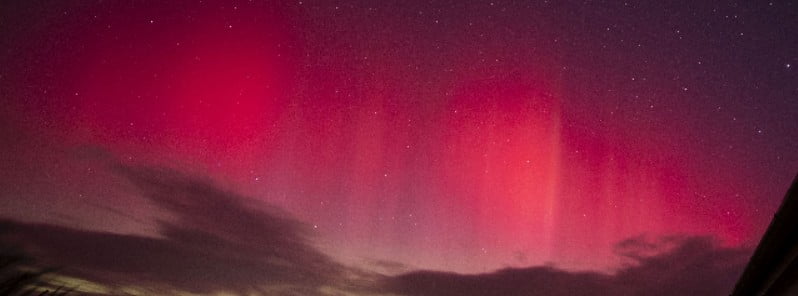Rare red auroras seen as far south as France

The Coronal Mass Ejection (CME) that was launched on September 22, 2023, hit Earth’s magnetic field on September 24 at 20:43 UTC, sparking a moderate G2 – Moderate geomagnetic storm and rare red auroras. Initially detected in Canada where magnetometer readings spiked by 129 nT, the event later became visible across Europe, reaching as far south as France.
CME arrived with a force much greater than anticipated, causing immediate geomagnetic disturbances. European skywatchers reported the rare occurrence of red auroras, visible even to the naked eye in some locations, including France and Scotland.
In Canada, magnetometer needles recorded an abrupt increase by as much as 129 nanoTesla (nT), signifying the onset of a G2-class geomagnetic storm. This was significantly higher than the storm’s initial forecasts had predicted.
In Europe, the geomagnetic activity led to the appearance of red auroras, a rare and often elusive phenomenon. Nicolas Drouhin, a photographer in Burgundy, France, captured the intense, albeit brief, red aurora that lasted for approximately 5 minutes. Observers in Scotland and Iceland also confirmed the visibility of the red glow.
Red auroras are a product of atomic oxygen at the top layer of Earth’s atmosphere. These atoms, excited by solar wind or a CME, emit their red photons at an extremely slow pace. The radiative lifetime of this transition is around 110 seconds, making these auroras particularly fragile and difficult to observe.
As the storm energy waned over North America, the red auroras became less pronounced. However, they were photographed as far south as Curtis, Nebraska, at latitude +40.6N, albeit not visible to the naked eye.
While the storm’s strength took scientists and observers by surprise, it offered a unique opportunity to witness and study the rare red auroras. These occurrences serve as significant data points for researchers examining the interactions between solar activities and Earth’s magnetic field.
Sākums ļoti iespaidīgs, bet uz rīta pusi kāds briedis uzelpoja uz objektīva. Otrais cēliens jau caur aizsvīdušu lēcu… pic.twitter.com/nHbbJPziMD
— Jānis Šatrovskis (@JSatrovskis) September 25, 2023
Aurora at Kinnego/Oxford Island, Lough Neagh, Northern Ireland around midnight 24/25 September 2023 @auroraalertsIRE @barrabest @angie_weather @WeatherCee @TamithaSkov pic.twitter.com/hpPtD65xMu
— Philip🦎EcotrakNI (@EcotrakNI) September 25, 2023
Last night, the Northern Lights threw a dance party over Lake Huron and the Port Elgin Harbour in Ontario, Canada // Sept 25, 12:45am #northernlights #aurora #auroraborealis #onwx #shareyourweather pic.twitter.com/1iiV7WUspd
— Scott Rock (@scottrockphoto) September 25, 2023
References:
1 Rare red auroras – SpaceWeather – September 25, 2023
Featured image credit: Chris Walker via SpaceWeather. Taken on September 25, 2023, at Mull of Galloway, Scotland

Commenting rules and guidelines
We value the thoughts and opinions of our readers and welcome healthy discussions on our website. In order to maintain a respectful and positive community, we ask that all commenters follow these rules.